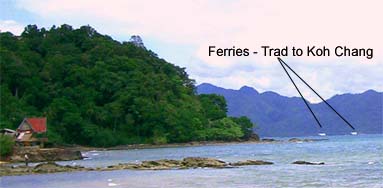 |
2004 TRIP TO THAILAND:
TRAVELOGUE
|
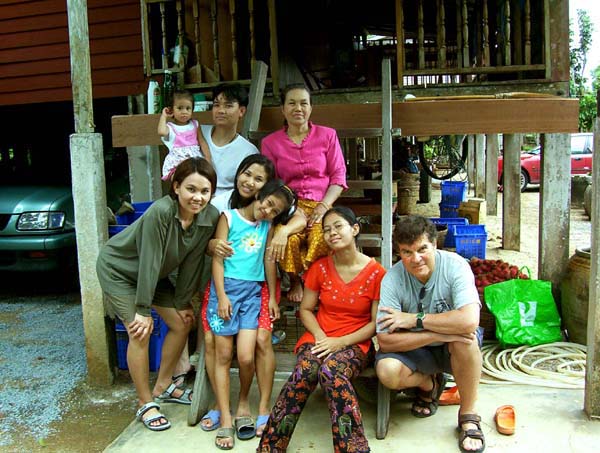 |
|
August,
2004
|
Yo my friends!
Here it’s been more than a month since returning from my
5-week visit this time to
Travel Tip
I left SF on May 14, making the most of our wonderfully civilized new BART (subway) connection, which drops you off right in front of the international check-in counters. From the West Coast, catching the red-eye to the Orient is—next to an expensive 14-day cruise—the best way to go: you’re tired when you leave, so you fall asleep quickly, and it’s night the whole 13 hours till you get to the first stopover—Japan, Korea, Taiwan, Hong Kong, Manila, wherever the cheapest consolidator sends you—after which the final leg feels pretty easy.
Necessary Introduction
One theme that struck me strongly throughout the trip, more strongly than ever before, is that this is now in many ways a startlingly modern country.
I remember feeling exactly the opposite way on coming for
the first time as a man-boy of 21. How different was their
life from ours, I thought back then. A single dirt
road into my district capital (like a county seat), with a population pushing
20,000. One telephone, at the post office. No
TVs at all. Most people walked or rode bicycles, sometimes 2 to a bike; if you
wanted to go to another town there were very funky, very crowded buses. You
bought any fresh food in an open-air market, where the smells could knock a
suburban American boy or girl back a few steps. My
thought then was that life in the
Now, even when I visit my old town, it’s another world. Two hard-surface roads in and out of town, televisions, air-conditioned pharmacies, digital cameras everywhere.
Ah, yes, the near ubiquitous air-conditioning. The hot box / cold box thing. Most especially in The Big Mango (Bangkok, for ye uninitiated) that was one of the most disconcerting experiences for me, going from an impossibly steamy, cloying heat straight into the icebox of a taxi, sometimes actually getting cold, then out again into the sweaty swamp for a bit before shopping in a freezing mall, back into the tropics, then onto the skytrain, air-conditioned again, out at the next stop to trek through the masses, sweat breaking through my shirt, and on and on, the sweltering day capped every night by bedtime in a cold room.
And cell phones! More than here, you see people walking alone and jabbering away, and those cartoony tones intrude on thoughts and conversations everywhere.
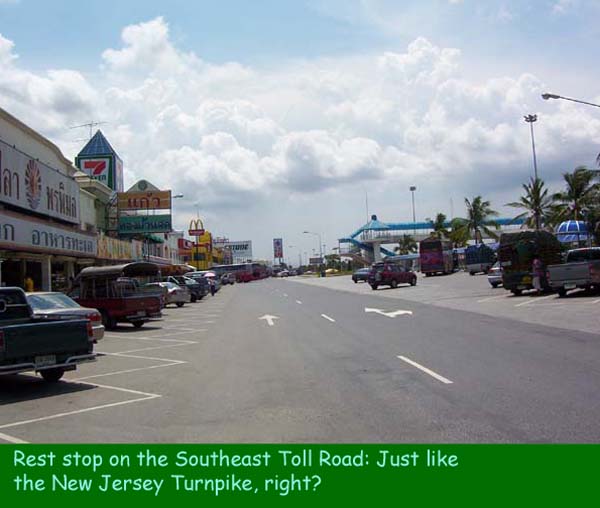 |
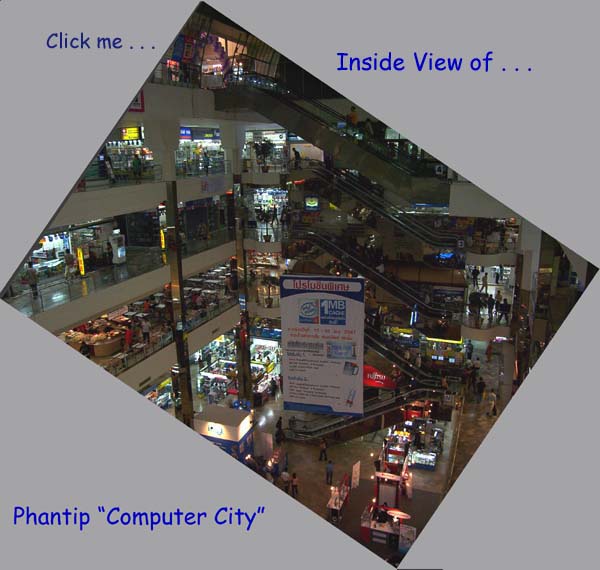 |
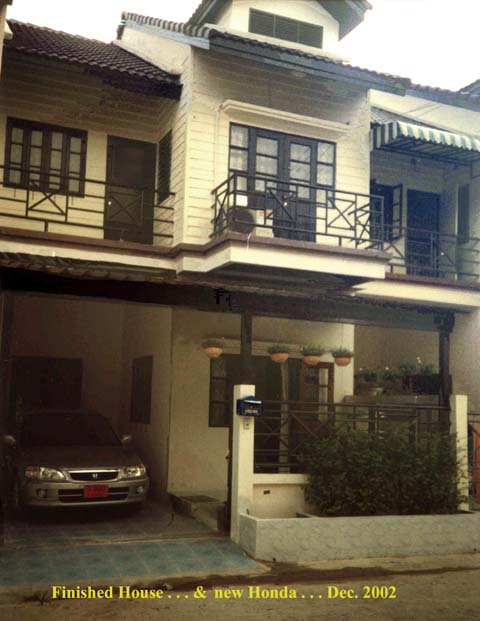 |
There’s one building that should
be a tourist attraction, because we have—or at least I have seen—nothing like
it in the West: 6 stories tall and with acre upon acre of floor space,
Then there are
But more telling than the physical indicators is the urbanity of the Thai middle class, which increasingly lives by the same rules and has the same everyday concerns as do Westerners. These folks watch sitcoms and international news on TV. They know the best cars, the best clothes and the best places to buy them. They have modern houses, with flush toilets (almost unheard of in my Peace Corps days), many with two-car garages & the stuff to park in them. And they’re beset by the same middle-class problems as many in the West. Last year I got deeply involved in a translation project: modern Thai short stories into English. Win Liawarin, one of the authors I translated, put his take on present-day life in the form of a tongue-in-cheek lexicon. Here’s a brief example:
Workplace: A
place where you have to show your face Monday through Friday so as to fill your
body up with stress (many scientists believe that stress is good for the body).
Back when I was a kid I used to envy
Stress: A
feeling that hits you the second you set foot in the office.
“Mr. Somsak called yesterday evening, left a note for you to call
back. Mr. Sathit informed us that there’s a problem with the order we sent
out—he was making a really big stink about it. At
I could go on. But hey, this is supposed to be about MY trip, right? And this is getting long already. And I have yet to mention the fun, nay, marry, far more, the joy and wonder which—as usual—were fairly constant companions in that still to me most magical land.
My Own Experience
Rather than give a blow-by-blow, which would take way too long, I’ll just hit on some meaningful highlights. (It’s gonna be way too long anyhow, just get used to it).
Home
A few years ago I “bought” a
3-bedroom, 2-bath town house 6 or 7 miles out an expressway from the center of
the Mango, in a small development, on an alleyway named after
The house is a quick car commute from Tee’s office, but not anywhere near a skytrain or subway stop, which makes it a little inconvenient for me. I do, however, have a nice mountain-bike that Tee has named “Rabbit,” and there’s an amazingly well-constructed and maintained tree-shaded bike path going most of the way into town. It’s a hot ride, but I did it a lot, usually capping the ride with laps in a beautiful big hotel pool you can swim in for a near-nominal membership fee. Getting/keeping in shape has been pretty easy . . . or would have been, if not for the incredible food.
So the 21st century is alive there. But where’s the magic?
The magic is everywhere. Did I
mention the food? Open the window, walk outside, the rich, seductive smells are
everywhere. My remembered Old Thailand is still there, everywhere, right amid
the big city: that’s one of the amazing things. Saffron-robed monks with bowls
still file through the streets every morning, and the many, many red-and-gold
temples are alternately silent, serene, meditative, then bustling with the activities of
fairs, processions, funerals, celebrations. Biking into town I pass fields of
brilliant green, (red roses, too, I see them bloom for me and . . . wait a
minute!) . . . I pass open-air
antique and knickknack shops, canals, restaurants, lotus-filled ponds, spirit
houses wreathed in flowers, laughing kids in school uniforms. And there is
really something to this “
The Thais have some very creative
ways of dealing with modern problems, solutions I’ve never seen anywhere else.
Here’s an example: you all know how frustrating it is to park in a crowded
parking garage. You get stuck behind someone waiting for a space, can’t get
around him to look for one yourself, when you do you have to go up another
floor, and another . . . . Anyhow over there if there aren’t spaces, you pull
up behind a row of parked cars, lengthwise, so that you block a bunch of them
from getting out. Then you set your wheels straight, put your car in neutral, lock the
doors, and go wherever you’re going. When someone finds your car in the way of
their getting out, they just roll it out of the way, then back again when
they’re done. I bet that seems bizarre. Wouldn’t work in the
In a moment of weakness I walked into a KFC. Why? Beats me, East meets West, guess I just wanted to see how that translated in that situation. Ordering food that tastes the same worldwide, the product was bland and predictable. But the service? Walking up to the counter, I see this big strapping Thai kid with an ear-to-ear friendly grin. He cheerfully takes my order, and when we’re all done, he bows his head gives me a big wai (Thai sign of greeting and respect), all still with that huge and obviously genuine smile. I got filled with a really warm feeling. Not an isolated incident . . . what is it, I thought? Compare that to what you’d see in the U.S, why is it different? At the top of my reasons is the spirit of Buddhism, that paradoxical mix of compassion and fatalism with acceptance and affirmation of life. Here everyone grows up surrounded by and instructed in that gentle philosophy, in whose name no war has been fought. Add to this the fact that the Thais have for hundreds of years been their own nation, with their own (Buddhist, incidentally) rulers, so that far from being resentful of foreigners, they’re more generally curious, open-minded, and able to trust than people in any country for thousands of miles in any direction. Those are a couple of guesses, but there’s more to it than that. There’s just something in the air here . . . aromatic, optimistic, and endlessly sensual. As my friend Bob Mocarsky says, “If there is such a thing as a fountain of youth, it’s here.”
Friends
Leaving for a moment the hangs with my musician friends over there, who are many and wonderful, here are just a couple of moments in a most active social calendar.
I was lucky enough to have two former Peace Corps Volunteers
from my original group there for overlapping stays, Ed Fallon and Brad Martin. Brad
I’ve seen a lot of in the last 10 years. Ed I hadn’t seen since training in
I’d been expecting to see Ed Wednesday, but he stayed in Koh Samet, sending his son Tip on ahead.
Tip is short for “Chanathip” —though American-born, he has a Thai mom and speaks Thai pretty well). We had dinner with a bunch of Tee’s officemates at a Korean barbecue place next to a racy massage palace, out in the open air, yellow fold-up chairs on a raised platform right by the sidewalk It was like what they call “steamboat” in Malaysia and Singapore: you cook the vegetables & other stuff in water boiling right there in a pot on the table. The container portion is like a moat, surrounding a central mound on which you lay pieces of calamari, etc. to cook before plopping them in the moated broth. Anyhow, the charming Tip was a big hit with the Thais and they tried to play matchmaker right away. Khun Gate, the very beautiful and classy-looking lady sitting right across from us happened to have with her a 15-year-old daughter, come direct from the classroom and still in school uniform. Gate made references to Tip and her daughter getting together, just the thing to put both of them at ease, right? —the daughter making faces and turning away, Tip pretending he hadn’t heard.
He & I, sitting there, with luuk thung (vaguely translatable as “Thai country music”) loud in the background, bustle and smiles all around us, still steamy warm in the milder evening as we filled up on that great food, shared the thought, oft-repeated among expats and expat wannabes alike: this place is addictive.
That evening he joined us as I
went out to play my horn in public for the first time this trip, to the nightclub
Saxophone—out by the
Anyhow Ed & I almost missed
each other. We were leaving for Koh Samet just as he had come into
Brad is another who’s spent more years in
We got to hang out quite a few times on this trip, including another visit to Saxophone, and capped in my last week by an Italian food fest at our house that I spent a couple of days preparing.
For that feast a bunch of Thai
friends came by, but most of my party time was spent after dinner on the front
porch guzzling Singha beer and debating the great issues of philosophy and
religion till
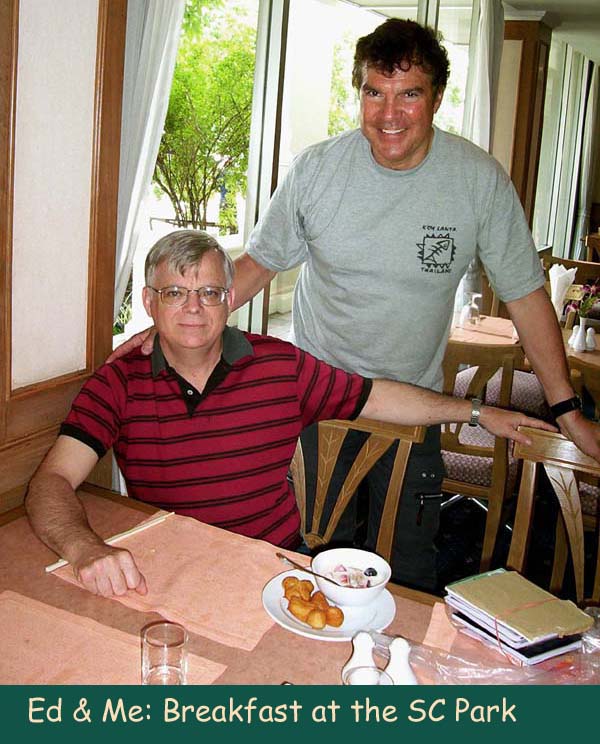 |
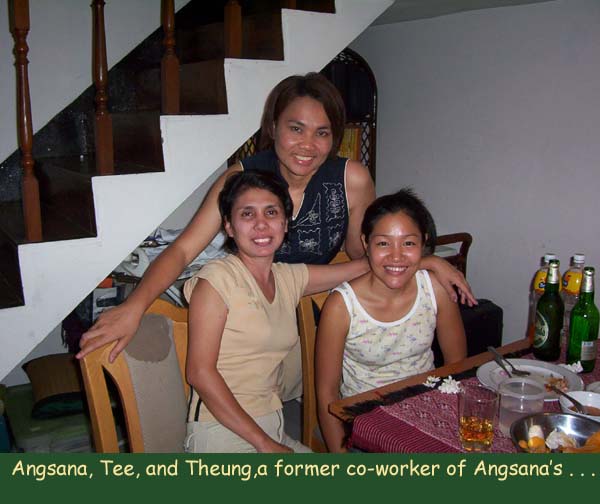 |
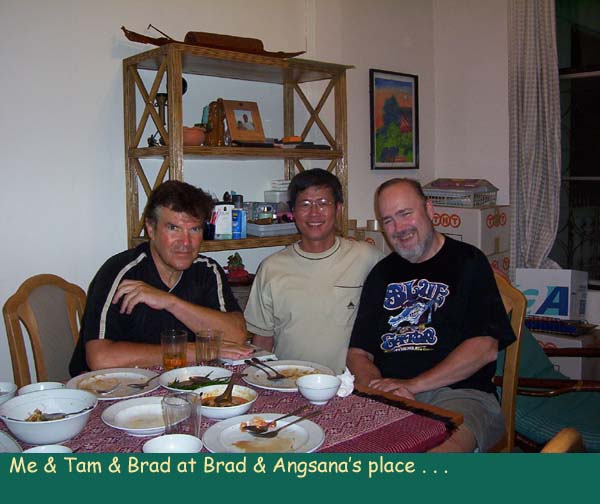 |
I wish I could describe all the great get-togethers with great friends that enriched and enlivened this visit—the welcome-home-dinner at Somphong with Angsana and friends, the gourmet meal with my hotelier friend Heribert Gaksch and his gorgeous sweetheart, on and on . . . but I’m probably boring you already. Sorry, I can’t stop yet, but I will move on to another aspect of the trip.
Excursions
In these five weeks Tee and some of her family took me to 3 Thai destinations I’d never been to before. I enjoyed them all and fell in love with one.
1) Koh Samet, the closest large island
to
The usual way to get out to the island is by a 45-minute trip on a rickety boat—getting on at low tide I had to climb from the dock onto the roof. Halfway down the ladder at the back of the boat, I felt it come loose at the top and start to tip over backwards! Made it down OK, but it was pretty crowded down there, looked like a lot of island locals with supplies they’d come to pick up on the mainland, only just a couple of Western types. We waited & waited till the captain decided the boat was full enough. When he finally left, he moved out about 15 meters, and then came back to pick up yet another bunch seen straggling down the dock. Definitely a “third-world” feeling: the best attitude for high-strung Farangs is just to lay back and dig it.
There are some beautiful beaches on Samet. We stayed at Ao Phrao, the only quiet one and the only one on the south side, and it really is nice: five or six small but comfortable resort hotels right on the beach, one with a diving school. No through traffic: the road, such as it is, ends here. Great snorkeling—clear water and lots of coral—on both sides of this little bay. Canoes for rent, cheap! Paddle out to sea, around the point, look across neighboring islands to the mainland. Here it was “rainy season,” and sunny every day. And—have I mentioned the food?—amazing Thailand’s amazingly fresh seafood dinners prepared by the amazing chef of the Ao Phrao Resort Hotel, enjoyed best beachside by candlelight. Two thumbs up. More.
Koh Samet doesn’t pass quite all my tests for paradise. I didn’t get a chance to roam around very much, but . . . though most of the island is designated as a national park, and foreigners have to pay a ß200 entrance fee (only ß20 for a Thai), most of the other beaches and bungalow hotels I saw were crowded and disheveled. Public transport around the island is mostly in the back of pickup trucks, up and down steep and deeply rutted dirt roads with scary drivers. But what am I talking about? Go to Ao Phrao: a good way to get away from the city for a weekend.
2) Hua Hin is a charming small beach
resort town on the mainland about 3 hours southwest of
3) Koh Chang (“
Koh Chang is the second largest
island in the Kingdom, smaller than Phuket, but almost as undeveloped as Phuket
was 30 years ago, probably because it’s off the beaten track, way over by
It’s about a four-hour ride from the Big Mango to the Koh Chang Ferries. These are nice modern boats, actual car-carriers, remind me of the Staten Island Ferry, just a bit smaller. The ride out to the island is smooth and pleasant. There’s no road all the way around the island yet, but what’s there is paved and well-maintained, though a little narrow, and steep and curvy in a lot of places. There are a lot of great and cheap places to stay, and the island has something for everyone: mist-shrouded mountains, magnificent waterfalls, elephant treks, beautiful temples, myriad surrounding islands with great canoeing, snorkeling and diving, some close enough that you can swim to them, underwater sea-battle wrecks, miles upon miles of brilliant beaches, rocky cliffs, hidden coves. There are a number of resort areas, and in between are long stretches of my remembered rural Thailand, villages, and gardens the way they usedta be, houses with wooden shutters on stilts, kids with curious stares, and uncut jungle reaching back into the hills. Oh, and that great home-cooked Thai cuisine, have I mentioned . . . ?
Then, of course, there’s satellite TV in your room, ha again! You want it, you got it. And the pool, if you can’t find enough water to swim in.
In conclusion: I have designs on Koh Chang. And you should go check the place out.
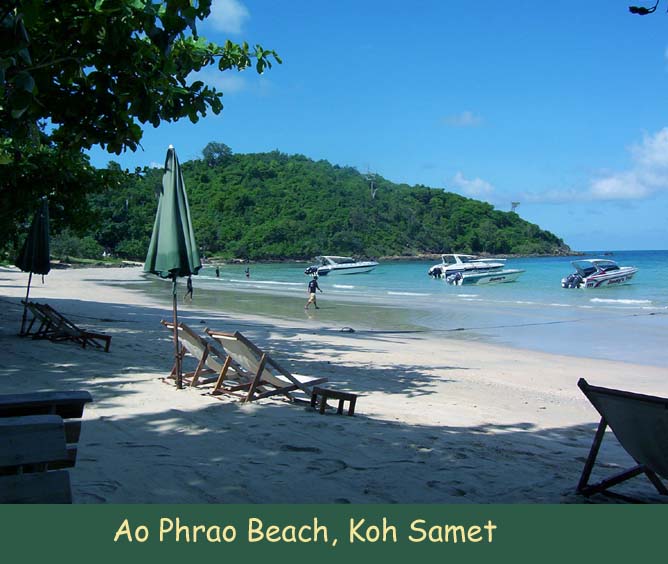 |
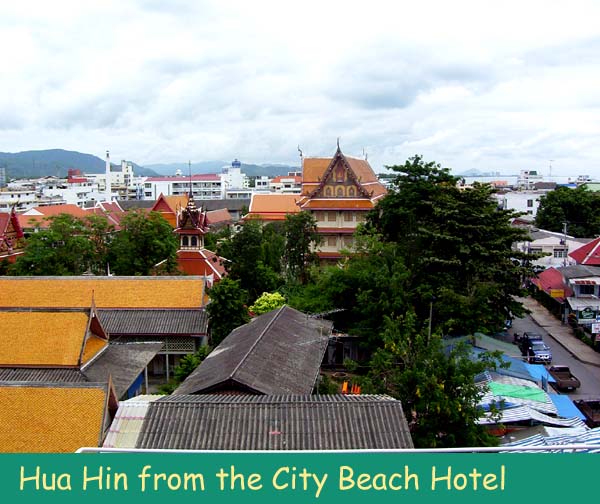 |
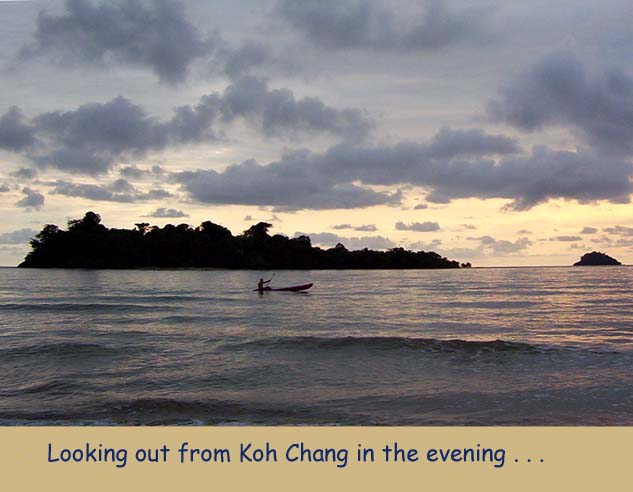 |
Music
I would leave this till last—if you’ve lasted
this long with me, you must be weary. Well, the jazz scene in
First off let me thank you, Randy Cannon, if you read this, for giving me a spiritual experience. Randy, who’s held down the steady spot at the Sheraton on Sukhumvit for some time now, is one of the greatest piano players I’ve heard, let alone had the good fortune to be able to jam with. I say this not only because he has great technique and jazz chops, or because all the other keyboard guys in town look up to him, but cuz he plays cuz he loves doing it, and playing with and off of the ideas of other players. A lot of great jazzers are self-contained and introspective—not Randy. He just spills all over himself and begs you to come out of your shell and blow, I love it. What did we do? Just simple standards. When I finally made it down there after trying for weeks, he called me up and we closed out the night with “What a Wonderful World”—which unlike any other band leader I’ve worked with, he didn’t want me to sing, for which I was actually most grateful—and “On the Street Where You Live.” Okay, these are nice tunes, sure. Standard standards. But what Randy does is way beyond. He takes a tune and pours meaning and feeling into it, gives it a groove you would not have imagined, then looks at you and invites you into that space he’s created, not in a way where you feel at all challenged or intimidated, just in the spirit of “hey, let’s have some fun!” And we all did—I got a tremendous rush off that encounter, walking in late at night, kinda tired, but walking out later feeling like I was just getting started.
Randy fills out his trio with a couple of fine musicians, Pong (bass) and Chris (drums). Most nights there's an American jazz singer, too. Miss you, guys!!! This group is a must-hear if you get to BKK.
Another
good jazz venue is the Oriental Hotel—there’s a quartet nightly starting at
There are other places, too. Saxophone has different stuff every night—salsa,
fusion, blues. Brown Sugar, behind
And that’s not the whole story.
In short, there’s some good stuff happening over there.
And . . . that’s why I keep going back.
Keep in touch!
—Peter